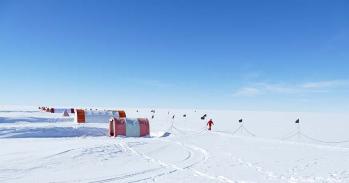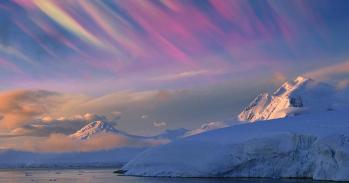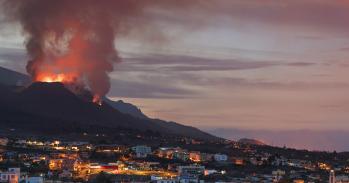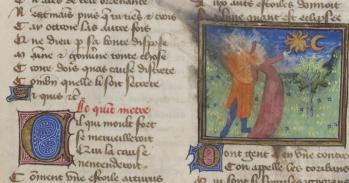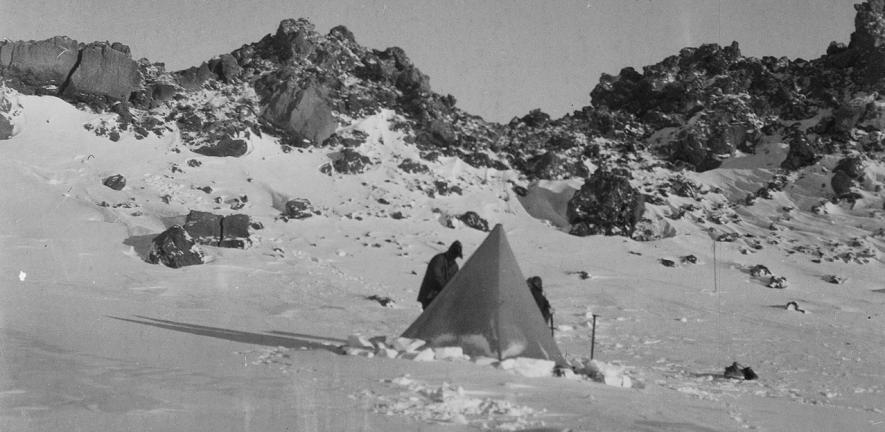
A century after members of Captain Scott's Terra Nova Expedition climbed Mount Erebus, the University of Cambridge’s Professor Clive Oppenheimer has located their highest campsite.
A century after members of Captain Scott's Terra Nova Expedition climbed Mount Erebus, the University of Cambridge’s Professor Clive Oppenheimer has located their highest campsite.
I was beginning to think I was looking for a needle in a haystack when I noticed a gateway to an almost hidden area I had not previously spotted on many routine travels. Within another minute or two, somehow, I’d found it.
Clive Oppenheimer
The first known visitor to the site since Scott's men left, his search was based on written accounts and historic images from the Scott Polar Research Institute.
Following his discovery, co-ordinated international action between the UK, USA and New Zealand is already underway to ensure the camp site is protected. An archaeological survey is also now expected to record the area and search for any items that may have been left behind by the 1912 party.
On Wednesday the 12 of December 2012, at 1am (New Zealand Time), Professor Oppenheimer re-enacted the ascent from the area of the camp to summit - exactly 100 years after Scott's men struggled through the thin air and freezing temperatures to the summit of the active volcanic crater.
Oppenheimer, a volcanologist, is in Antarctica as part of the United States Antarctic Program. He said: “Despite many scientific missions to Erebus over the past four decades, no one has ever discovered the original ‘highest camp’ – as it was described in a 1913 account called ‘Scott’s Last Expedition’.
“Looking through the thousands of photos on SPRI’s Freeze Frame portal, I saw several pictures of the 1912 site, tried to memorise them, then fired up a snowmobile and set off around the summit cone. I was beginning to think I was looking for a needle in a haystack when I noticed a gateway to an almost hidden area I had not previously spotted on many routine travels. Within another minute or two, somehow, I’d found it.”
In 1912, a team from the shore party of the Terra Nova Expedition climbed Mount Erebus. The team was led by geologist Raymond Priestley and included Tryggve Gran, a Norwegian ski specialist; Frederick Hooper, formerly a steward on the Terra Nova, Able Seaman Harry Dickason RN, Petty Officer George Abbott RN and geologist Frank Debenham. They undertook mapping and collected geological specimens.
The climb is of historical significance as it was during his time on Mount Erebus that geologist Frank Debenham had the idea of a 'Polar Research Institute'. After serving in World War I, Debenham was the founding Director of Cambridge University’s Scott Polar Research Institute.
SPRI Director Professor Julian Dowdeswell said: “Debenham's idea for what was to become, through his efforts, the Scott Polar Research Institute, came during his time on Mt. Erebus exactly 100 years ago. It is fitting that this camp site should be revisited for the first time during the centenary of Scott's last expedition.”
Philippa Foster Back, granddaughter of Professor Frank Debenham and Chair of the The United Kingdom Antarctic Heritage Trust (UKAHT) said: "Clive Oppenheimer's location of the original 'highest camp' is a wonderful addition to all the activity which has taken place throughout 2012 to mark the centenary of Captain Scott's expedition. It is a reminder of both the dangers and thrills of Antarctic science and a fitting tribute to the great legacies of exploration and discovery left to us by all the brave men of that party"
Added Oppenheimer: “I was tremendously excited to discover the camp site. In my mind’s eye, I saw the four men fussing around their tent – transposing again the historic photographs on to the snowy stretch in front of me, I couldn’t help smiling and saying ‘hello boys’.”
This work is licensed under a Creative Commons Licence. If you use this content on your site please link back to this page.


